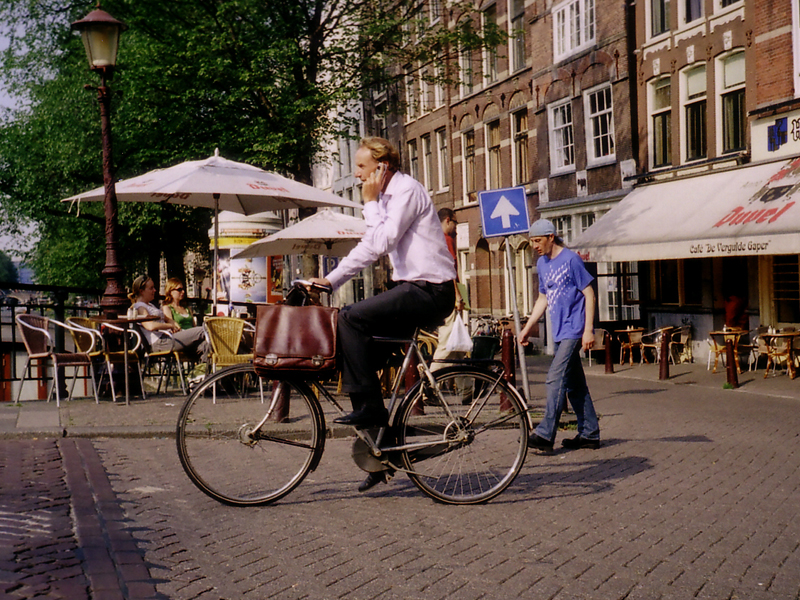I went to a very interesting and inspiring presentation last week at San Francisco’s Public Library. The name of the event was Lessons from Amsterdam: How San Francisco Can Bicycle toward Greatness, and the three people who spoke were:
Bart van Bolhuis, The Netherlands Consulate General in San Francisco
David Chiu, President of the San Francisco Board of Supervisors
Leah Shahum, Executive Director of the SF Bicycle Coalition
Leah had just returned from an 8-month sabbatical in Amsterdam (I know, poor her) to study bicycle culture in Amsterdam. David Chiu, the only SF supervisor who rides his bike to work every day, had also gone on a one-week learning trip to Amsterdam last year. Mr. van Bolhuis is the classic super laid back Dutch official, the kind of person you’d see riding his bike from a coffeeshop to work, like this guy:

So, all in all a great group of people, passionate about biking and making cities more livable, plus funny and eloquent. As an added bonus, they each showed a bunch of really yummy slides, which I will try to make up for with some eye candy of my own. The room, 235 capacity Koret Auditorium, was packed with bike people from all walks of life. For just a couple of hours we got a taste of what it would feel like if everyone in the world was a cyclist.
To get us all warmed up, they showed this cool little video, entitled This Is Amsterdam And This Is My Bike.
[youtube=http://www.youtube.com/watch?feature=player_embedded&v=EOkqTDdtlc4]Mr. van Bolhuis took to the podium first, and he cited some pretty stunning numbers:
30% of all Dutch people ride their bike to work
49% of primary school kids in Holland ride their bike to school
The 2010 Benchmarking Report on bicycling and walking in the U.S., released by The Alliance for Biking and Walking last year, confirms how far ahead of everyone else the Dutch are in kicking the driving habit:

 Mr. van Bolhuis also said that Amsterdam’s and The Netherland’s financial commitment to supporting bicycle infrastructure (I think he said they’ve spent $600 million in bicycle infrastructure since the mid-90s) has paid many dividends beyond just the obvious traffic relief and energy savings. For example, the Dutch have one of the lowest obesity ratings in the world, translating directly into huge health care savings. He also spoke of the huge business boom generated by their nationwide bicycle master plan, from the sales of over 1 Billion bicycles since 1990 to booming small businesses in downtown Amsterdam due to the influx of people on bikes. As you can see in the chart, funding bicycle infrastructure is in direct proportion to the number of people on bikes, regardless of where you are. If you don’t invest in it you can’t expect to reap any of its benefits.
Mr. van Bolhuis also said that Amsterdam’s and The Netherland’s financial commitment to supporting bicycle infrastructure (I think he said they’ve spent $600 million in bicycle infrastructure since the mid-90s) has paid many dividends beyond just the obvious traffic relief and energy savings. For example, the Dutch have one of the lowest obesity ratings in the world, translating directly into huge health care savings. He also spoke of the huge business boom generated by their nationwide bicycle master plan, from the sales of over 1 Billion bicycles since 1990 to booming small businesses in downtown Amsterdam due to the influx of people on bikes. As you can see in the chart, funding bicycle infrastructure is in direct proportion to the number of people on bikes, regardless of where you are. If you don’t invest in it you can’t expect to reap any of its benefits.
But the Consul General as well as Leah Shahum pointed out that it wasn’t always like this. Before the oil embargo in the 1970s, Amsterdam and most other Dutch cities were overrun with cars, just like in the U.S., but the oil crisis really mobilized a small but vocal faction of activists to demand large-scale, structural changes. They had to fight hard against the status quo, but they prevailed, and today bicycles are the status quo in Holland.

One of the huge yet intangible impacts of setting a policy dictating that it should be easier to ride a bike than to drive a car is that it shifts perception so radically that biking just becomes a normal part of culture, a routine that people don’t even think of as something to do but it’s just second nature to their everyday lives. It was an observation David Chiu made from his time spent in Amsterdam: “Nobody thinks of biking as what they do or don’t do, it’s just part of the culture.”
Like picking up your kid from school:

Another thing that Supervisor Chiu pointed out that was close to his heart was the fact that there are virtually no bicycle fatalities in Amsterdam, while we’ve had a remarkable 1147 bike accidents in San Francisco over the past two years. The fact that nobody in Amsterdam wears helmets doesn’t seem to make riding a bike any less safe. As the Consul General kept saying, nobody feels any danger from riding a bike, and while that may seem miraculous it really is the consequence of very deliberate city planning. Basically, the difference between riding completely safely without helmet or getting killed with a helmet is the difference between this street in Amsterdam:

and this one in San Francisco:

Leah Shahum agreed that creating the right kind of environment is the key aspect to not only getting more trips to be taken by bike but to change our entire culture to adopt the bicycle as a normal way of getting around. She also pointed out some of the great trends in San Francisco, where 16% of people ride a bicycle regularly and one in every 76 residents (11,000 total) is a member of the SF Bicycle Coalition. David Chiu added that currently 7% of all trips to work are taken by bicycle and that the city has adopted a 20% by 2020 goal, which he immediately challenged to increase to 50%.
They also talked about the success of some ideas that were met with a lot of resistance at first. For example, Sunday Streets, an event that closes stretches of a neighborhood’s streets to automobile traffic and opens them to pedestrians, bicyclists, and activities for several hours on a predetermined Sunday has been a huge success. Chiu said that a couple of years ago when they first started doing Sunday streets he got a lot of emails from merchants, complaining and worried about losing business. Now he’s getting daily emails from business people asking when the event is coming back to their neighborhood.

Ditto with the city’s Pavement to Parks program that seeks to turn car-centric asphalt spaces into new public plazas and parks. Chiu says the city is now completely backlogged on applications by merchants who want to turn the parking space in front of their business into a “parklet.”

Chiu quoted Portland’s city traffic engineer as saying that building bicycle infrastructure is by far the most effective return on investment a city can get. (Portland should know as they’ve really invested heavily in bike infrastructure for U.S. standards). Compared to building new roads it’s really cheap, and the benefits so vast and widespread that it should really be a no brainer.

San Francisco has really come a long way, and the next big step is the Connecting the City project, an ambitious vision of continuous, crosstown bikeways. But if we want to be anywhere near Amsterdam we have to look a few generations ahead. As Leah pointed out, we have to get our kids on bikes at an early age, so they can learn the motoring skills needed to be confident and safe cyclists.


And while programs like the SF Bicycle Coalition’s Bike to School Day and Freedom from Training Wheels workshops are invaluable resources, we’ll know we’ll have arrived when this image becomes just another day in the life…

o~O~o~O~o~O~o~O~o~O~o~O~o~O~o~O~o~O~o
all photos by Sven Eberlein








I love this post, Sven.
I can imagine that we would first have to get Americans fit again before we could do a lot of this. It would start from the children: kids riding bikes to school and to play and turning it into a lifetime of bike riding.
I was involved in trying to get grants for a federal program in our community called Safe Routes to School. http://www.saferoutesinfo.org/. The idea was to get kids to walk and bicycle to school. It provided funds for bike paths and bike safety presentations among other things.
We won’t be able to turn our country into a nation of bicyclers overnight but it would be great to see it at least get some interest.
Hi Jan, I guess it’s a bit of a chicken and egg thing. On the one hand you have to be a little fit to ride your bike, and on the other riding your bike is going to get you in better shape. I think at least for folks in flatter areas getting on your bike is not that insurmountable of a challenge and I think a good way to start getting in better shape. Just start with a couple of blocks at a time, and work it from there. The safe routes program sounds great, it really hits at the core impediment to more bicycling, safety. When you have safe roads, bicycling is really no more than child’s play. It also means it’s fun. The thing is people strap their bikes on their cars to go cycling at the park on the weekends, which proves that the bicycle is something that brings joy to people. So we just have to work on creating the kind of infrastructure, so that folks can have fun every day. : )
Let me know if you’d like this post at the great and amazing Blogistan Polytechnic Institute.
Sven, I would love if you would crosspost for us.
Could you do it for Monday night? We do EcoNews on Sunday night but Monday is all yours.
Maybe it would be a good idea to make bicycles with an electric motor (solar rechargeable) affordable for more people. Even if I have someone in the family who still run bicycle races up to over 75, and I use myself my bicycle a lot, for certain people, considering the hills in San Francisco, it could be a helpful good alternative to the car?
Yes, electric bikes are a great solution for steep-hill cities like San Francsico, and I’m starting to see them around town. Here’s one I saw parked at the farmers market a few weeks ago…
I still find someone someone talking on a cellphone, during he is on his bicycle in public space, irritating.
I agree about cellphones. Not just on bikes, but I see so many people talking in the street and being so distracted all the time, like a bunch of lost souls. It feels like nobody is really present anymore, always engaged in mostly meaningless chatter with somebody and somewhere else. But I guess the positive aspect of that photo, at least from an American perspective, is that by creating a better infrastructure for bikes and pedestrians and reducing the number of cars we could feel so safe and comfortable while riding our bikes that we could be engaged in casual cellphone conversation while doing it. While it sure is annoying, at least the danger of getting hit by a car is very minimal.
I observe in the last , that the middle class appropriates the therm ecology for her own purposes and transforms it into a reduced concept who improves their lifestyle but avoids a deeper view and critic on the structures and the system.
Cellphones are socially, environmentally and politically as questionable as cars.
How resources gets obtain, matters as much as how they impact the user, and our social life.
Agreed. Electronic waste is one of the biggest and dirtiest secrets of the 21st century so far. I’m frankly shocked at the nonchalance with which we’ve become accustomed to buying and disposing phones and other gadgets on a yearly basis. Nothing is made to last. The computer I’m typing these lines on is 5 years old and considered a relic. Pretty soon it will become useless. The industry calls that “planned obsolescence.” The whole system is designed for us to be wasteful. If you don’t want to waste, you have to swim against the current every day, and even then you’re sometimes powerless. But it’s still worth the fight, always…
This ending system appears missing real creativity.
This advertising of the same kind of objects with supposed improvements, who lead only to more dependence and expose citizen to more control, affects me through their unimaginative boringness.
I enjoy life without all these absurd objects who are not attractive to me.
By swimming against the mainstream, I have increased my ability to respond to the absurdity of the system. I wonder sometimes how stupidity is more and more required to perpetuate this structures.
a lot of the problems I think have to do with the global reach of marketing and advertising. Everything is reduced to the lowest common denominator, like one bland flavor that is the least offensive to the biggest number of taste buds. I do agree that it breeds a lot of conformity and stupidity. While I don’t like to be too hung up on “the good old days” I do think that we’ve gotten rid of a lot of ways of doing things in the name of technology and progress that worked just fine before. There are certainly people who use some of the new technologies in very creative ways, but the vast majority of people are just consumer sheep and wasting a lot of resources and brain cells.
Considering the disastrous futures in some heads, praising their own neurotic world view concepts as technological improvement of the human…..guess, we need to redefine what we truly want, individually and as society.
[…] City of the Year in 2010 is celebrated for its beautiful people-centered downtown. Or take Amsterdam, the flagship of pedestrian- and bike-friendliness that wasn't always so. The Dutch city became […]